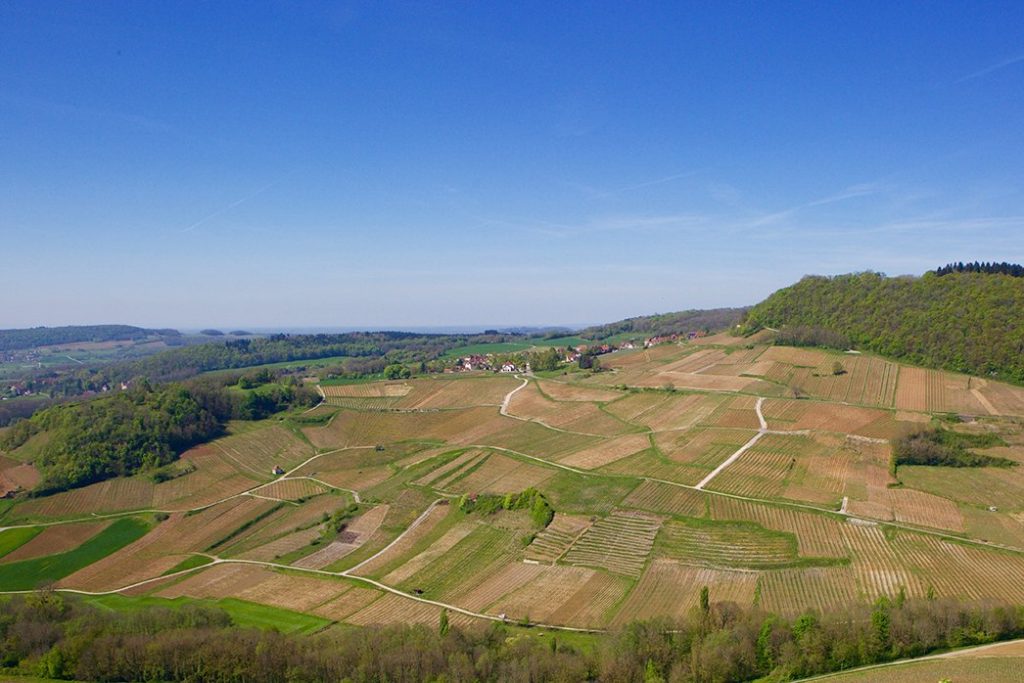
As the road into the Jura Mountains got steeper, a cliff loomed to our left like a slanting wall of neatly stacked flagstones, done by some midcentury architect with a sense of humor. Each layer of limestone had been laid down as sediment over countless years and then striated vertically every foot or so as the mountain pushed skyward. We turned off into an overlook where we could see the entire patchwork below: vineyards, yellow and green fields of canola and wheat, tan and terracotta villages encircled by bushy forests all quilted together under the bluest sky.
The town of Château-Chalon was just a little further up, perched atop a promontory on the first step of the mountain range. The whole village is constructed of the same limestone and in nearly the same shapes as the cliffs below, only (of course) stacked more horizontally. Some walls were spackled over with cement that had long ago crumbled away like skin in spots to reveal the muscle of stones underneath.
As we made our way down a narrow street looking for lunch, we passed low arched doorways with doors painted alternately white or red. The place was deserted, with most of the windows shuttered. Maybe only five people materialized from one of these squat structures, then hustled off in the other direction. It was like we had entered a medieval hamlet closed up for a possible invasion.
We came to the first destination on our short list of choices from the Internet, Le P’tit Castel, and looked through the darkened window. Inside, the tiny room had about six tables, all full. We went on to the second, Auberge du Roc, and it was the same story. The whole town had apparently congregated where we wanted to eat. The third and final restaurant was closed. It was a pity, since all three were highly rated and looked like places where Hobbits might dine.
Slightly discouraged but not defeated, we retreated to the bottom of the hill to a restaurant on the side of the road in a new beige stucco building that would have fit in well in suburban Los Angeles. (It will remain unnamed). The interior was all orange walls, beech furniture, rubber tablecloths and cheap brightly-colored pastoral art that must have been hung in the 1990s.
Like many restaurants all over France, they offer a cheap prix fixe menu: three courses with a glass of table wine, for eighteen euros. What a bargain. Yet I can’t recall the first course, and the entrée was only memorable because what was listed as pork came as a slice of ham, like one might get at a HoneyBaked restaurant.
For the third course, I passed on desert and ordered fromage blanc, only because I had no idea what it was. For those who don’t know, what I got was a cup of semi-liquid cheese curd reminiscent of Greek yogurt. I took a few bites, and then watched enviously as Ted sliced into his nice plate of real cheese, including some delicious looking Comté.
Always health-conscious, Andrea wisely demurred on the third course. I made a note to self: call Le P’tit Castel ahead of time. To be fair, the place where we were eating was also highly-rated and had a great selection on their expanded menu. I may have just chosen poorly from the limited prix fixe, and/or on an off day.
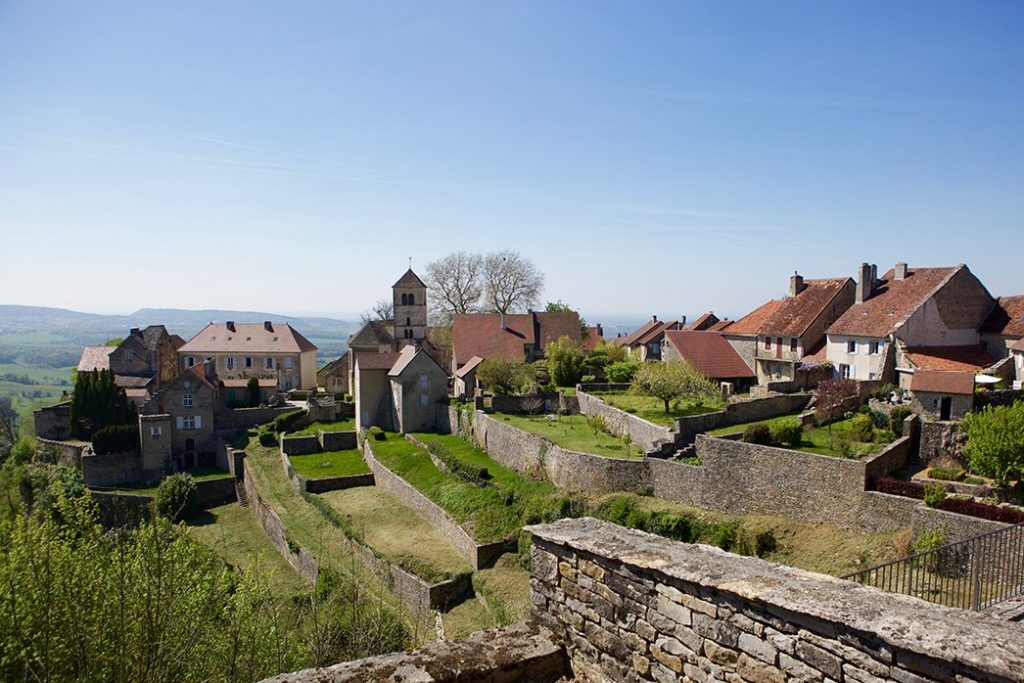
We still had some time to kill before our appointment with Jean-Claude Crédoz, so we returned to Château-Chalon and parked at his winery before wandering through town. One road led us to a stunning view of some palatial houses on the cliffs overlooking the beautiful rolling countryside far below. Tiers of green yards lined with ancient rock walls curved along the hillside. The pinnacle of a Romanesque church from the eleventh century towered over the village rooftops, begging us for a visit.
After getting lost in a maze of concrete and stone, we finally found the old edifice with the cross on top, named for Saint Pierre. A breath of old wood and leather came from an open arched doorway. I went into the darkness and stood in awe of the silence, the history. The place had none of the grandeur of a cathedral in the big cities of Europe; it was a place of austere worship. A local glanced at me on the way out and I imagined suspicion there. Heathen that I am, I immediately backed out, somehow intimidated by a god I don’t believe in, or maybe, by that cold look from the believer of something I don’t understand.
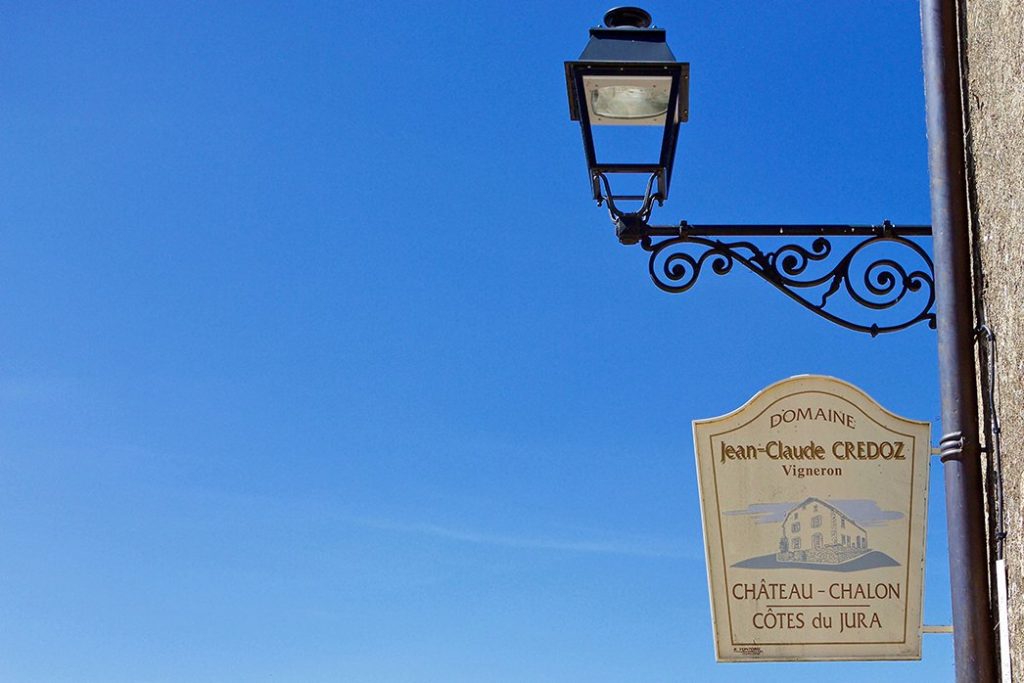
We got separated from Andrea, the shutterbug, but rejoined her back at Domaine Jean-Claude Crédoz. He immediately came out and offered warm and firm handshakes all around. He spoke no English, so it was left to Ted to translate. I understood chunks, but as any intermediate student of a language can confirm, quick speaking natives leave one in the dust. He summarily showed us his two winemaking hangers, with their towering steel tanks, then cut to the chase and led us out to his SUV for a vineyard tour.
Crédoz is medium height, very thin and wiry, like a man who works so much he forgets to eat. He has a big mop of straight dark hair parted down the center above a face that’s seems to have more of a permanent pink burn than tan. A thousand super fine crow’s feet fan out from the corners of his eyes all the way to the hair on his temples and halfway down his cheeks, when he squints and smiles, which is to say, almost always. It was the face of someone who works in the sun every day most of the year, tending to his land like the most dedicated of farmers. (Find a little more on Crédoz here).
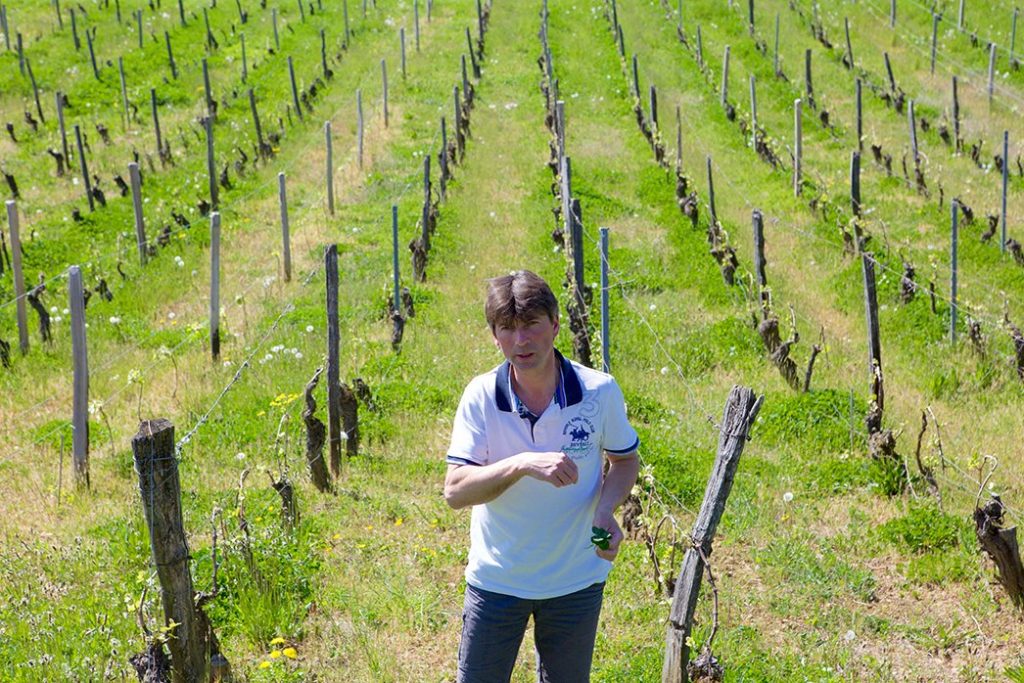
This was the crux of the my trip with Ted, to meet the vignerons he imports who are not the aristocratic château owners of Bordeaux, lording over their field workers, but guys who work the grape from bud to glass, right alongside their employees. To hear Crédoz talk about his land and his process, his passion, dedication and determination came through even when I only caught every other word since Ted was so absorbed that he was only summarizing bits and pieces.
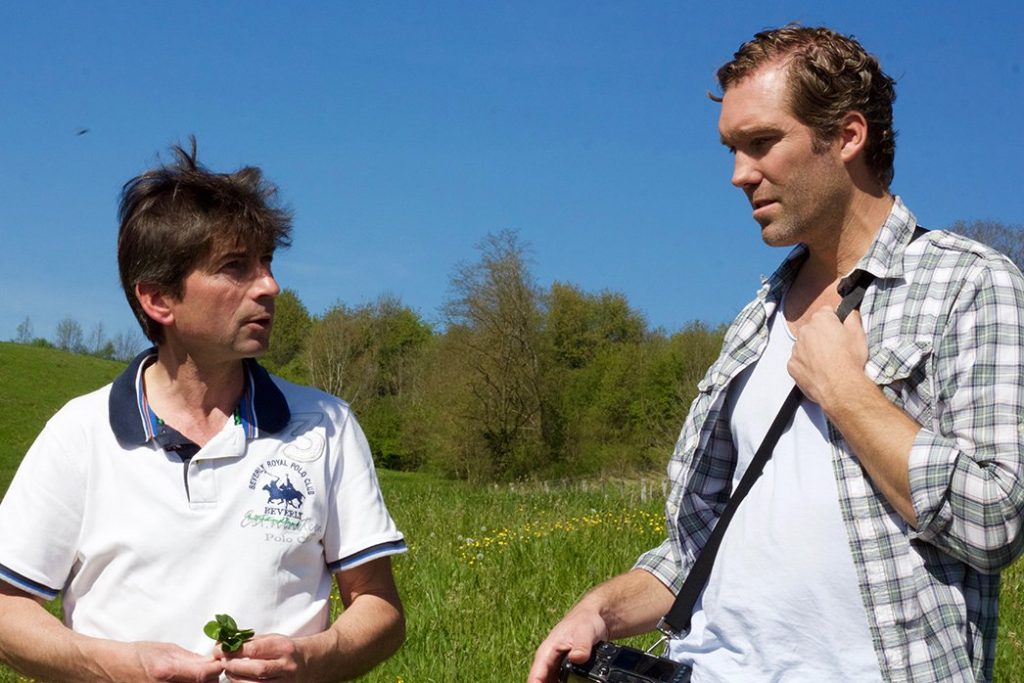
The first stop was on the Château-Chalon slope (the first image in this chapter), which faces west in the valley down below the town, where half of his grapes are grown. Then we headed over to the AOP “Côtes du Jura” slopes, which face southwest. Crédoz pointed out that this variance in direction (or “aspect” as it’s called, which can also refer to the slope of the hill) makes a huge difference; as one would expect, it affects speed and ease of ripening and therefore the harvest times in the different areas.
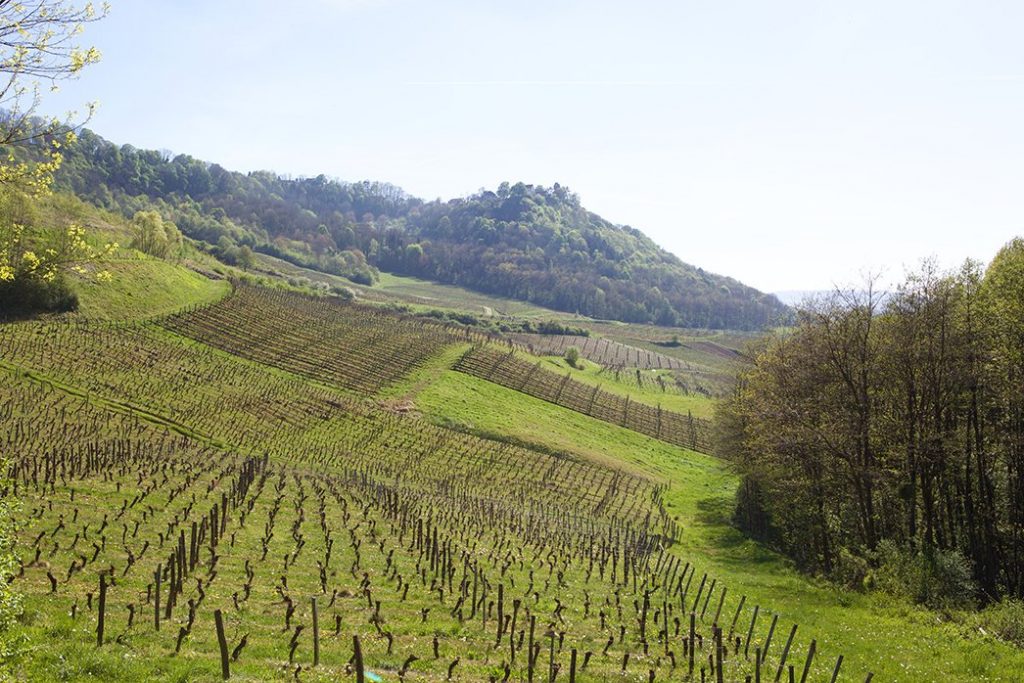
We got out at every parcel to examine the vines, with their early season young buds and small clusters of leaves. Andrea took stunning photos of the rolling landscape, occasionally showing me the screen on her camera. Ted did so too, but not before he aimed his lens at the ground to get close-ups of the dirt, soil and healthy greenery.
Crédoz uses natural techniques, and his vineyards were covered with natural grasses and weeds over cracked beige clay and chunks of marl. Ted picked up pieces and crumbled them in his fingers, took sniffs and looked closely with his magnifying loupe. It was all very different from the overgrowth and orange decay on some of the other parcels we had seen down below.
Andrea and Ted took quick candid photos of Crédoz as he spoke and he humored them with shy grins when he wasn’t trying to ignore the attention. In this age of social media, they carefully strategize what they want to post and say about their producers.
Like many natural winemakers, Crédoz uses the undergrowth vegetation as fertilizer by plowing the rows every other year instead of using herbicides, killing two dirty birds with one stone. He also shuns the use of manure, which, he said, artificially induces power in the vines, making the grapes ripen too fast to develop the desired complexity.
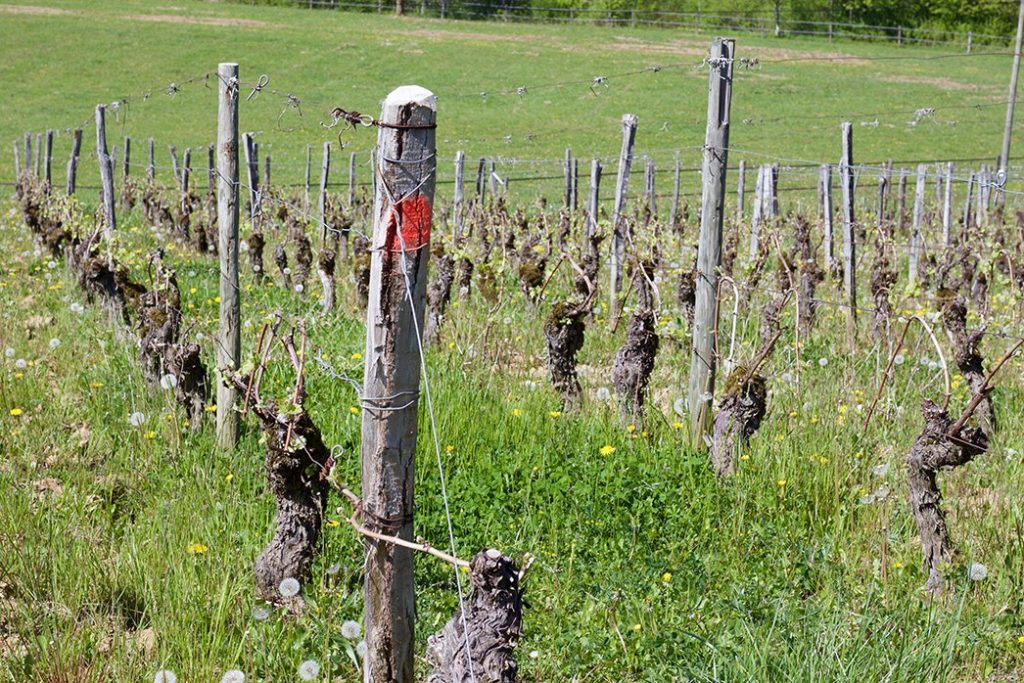
It is the inclination of purists is to do exactly the opposite of boosting growth, to take steps that make the grapes work harder for their dinner. Another technique is to plow just to each side of the vines so the roots have to dig deeper and make their way down to the rich minerals and other nutrients well below the surface. Yet another way is to allow clover and other grasses to grow close to vines in higher precipitation areas where they can steal water, which also forces the roots downward where, Ted says, “they find their way to more interesting earth, like decomposed bedrock and stone, the bones of a true vin de terroir.”
Crédoz gestured in different directions and noted the ages of some of his vines all over the hillside. While some would consider his forty-year-old chardonnay, old vines, he doesn’t agree. But he’s pickier than others about what he classifies that way, which is easy for him to do, since some of his holdings have been around for 120 years.
Next: Crédoz’s Cave and Bar

